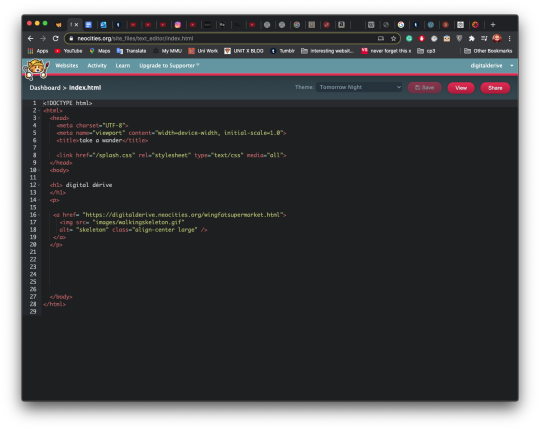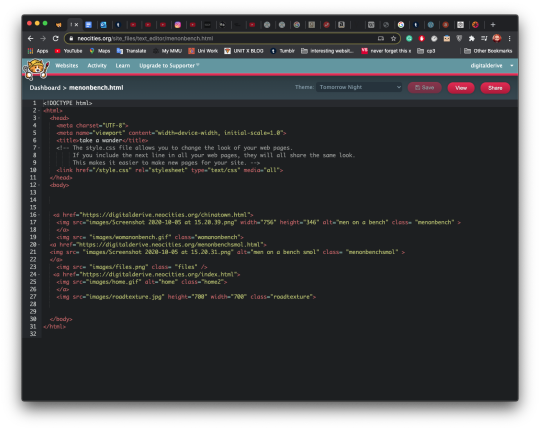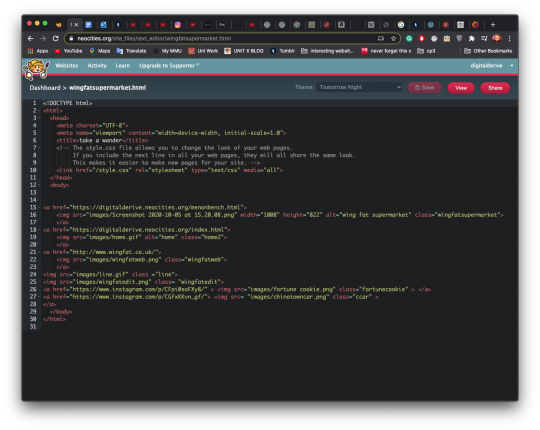amismithdigital
53 posts
Don't wanna be here? Send us removal request.
Text
Wasting Time On The Internet by Kenneth Goldsmith
0 notes
Text
SP4A Reflective Summary
My practice is informed by my interest in the internet and how we interact with it. After researching Guy Debord’s Theory of the Dérive I became interested in the dérive and how this can be translated into online spaces. Despite the internet’s vastness, the typical user may only visit the ‘main sites’ (Facebook, Twitter, YouTube, Amazon, etc). I am interested in using the dérive to encourage users to explore the internet and prevent them from limiting their experience to social media and online shopping. I have been exploring ways of undertaking my own digital dérives and experimenting with ways of taking the user on a digital dérive. I am also interested in challenging the restrictions and lack of customisation offered by social media sites, something I plan to explore further in my essay. Sites like Facebook allow users to upload content to the site and fill out a profile however, there is little room for self-expression and individuality resulting in uniformity. I am curious about how our offline personalities can be better represented through creative freedom online. I have explored these themes in my ongoing project, www.digitalderive.neocities.org, a website that users can explore through clicking on a mixture of my own and found images, GIFs and videos.
Research has been paramount to my practice, I have read a wide variety of texts to inform my work and my ideas, and to learn about the context in which my practice resides. Texts by writers such as Alison Colman and Claire Bishop have helped me to understand the history and context of web/net art and better understand the internet as a medium for work rather than simply a platform for distribution or a concern/theme in my practice. Furthermore, my research into the sites and ethos of GeoCities has helped me understand the history of the internet and its culture. In making my own websites I also had to research HTML and CSS and learn to code. This was perhaps the biggest challenge I faced as I was learning as I worked. I felt this was important to my practice as teaching oneself to code using books and online resources was a part of the internet community and culture of a place to share skills and knowledge. I don’t think my work would be as interesting or exciting had I restricted myself to work within a website builder or template.
As someone who works in digital and new media, my blog has become a sort of digital manifestation of a studio space where I can articulate my thoughts on what I’ve read, seen or created and this helps me to process my ideas, ask questions and identify what to explore next.
I am going to continue working on my website, www.digitalderive.neocities.org, and create more websites to continue exploring my themes and develop my coding and website building skills. I want to further explore digital dérives by undertaking more dérives and experimenting with ways of recording these, perhaps with moving-image, GIFs, or images.
0 notes
Photo





https://digitalderive.neocities.org/
Following my research into the dérive and experimenting with carrying out my own digital dérive, I wanted to find ways of presenting a record of my dérive. I first put all the images into a powerpoint but I didn’t think this expressed these images in the most interesting way and didn’t think this format took full advantage of the digital medium. However, this could be something to return to in the future maybe when I have more time to fully explore and experiment with the software. Also, powerpoints are performative in nature so maybe I need to not only experiment with the software but also with ways of performing, either face-to-face or over zoom/video.
This led me to look towards website building particularly after seeing the websites of Molly Soda, Erik Bernacci , www.housefly.neocities.org, Movie Computer Interfaces to name a few. I had no experience of creating a website so I started by looking at websites that help you to create websites such as Tumblr, Squarespace and Webflow. However, I found that these sites didn’t give me the level of customisation and freedom that I was looking for. Each website builder encouraged me to pick a template (the standard ones being free and more complex or interesting ones costing), I really didn’t want to pick my site from a template as I wanted it to be unique and I wanted to experiment with the layout and elements of each page rather than be restricted to a certain look. This led me to a site called Neocities, Neocities is a free web hosting service that aims to revive the ethos provided by GeoCities before it was shut down. I really was worried about learning to code as I thought it would be too complicated or too difficult to accomplish the kind of site I wanted to make. However, I made a very basic start to my site which involved a header and an image. I then made more pages with links from each image to the next page so that the user could move through each page by clicking on the images, revealing a new page and image each time. I started learning to code from various online resources like HTML Dog which taught me basics like adding text, images, what CSS was and how to use it to make my website more attractive. I felt that i needed a guide that very clearly and simply explained the basics so that I could create a good foundation of coding knowledge before I moved onto more ambitious additions to my site so I bought HTML & CSS by Jon Duckett. I read through the basics of this book and now i use it as a point of reference/a guide when coding, so I will have it open next to me when working on my website to help if i’m stuck or if i need guidance on something. I think that learning to code and constantly learning more about website building, design and the internet as a whole/how it works has become an important part of my practice. I think it’s also very appropriate to the work I make, as at the point of the early internet there were no website builders and teaching yourself to code through online resources and books was the only way to create a website. My website, www.digitalderive.neocities.org, is a manifestation of my own digital dérive but also a digital dérive for the user. I used the images from my google maps dérive for the basis of each page and then collaged each image with GIFs, found images, more of my own images and videos. Some of the images and GIFs link to other pages on my site whilst others link to external pages. The point of this is to allow the user to explore and discover my website and parts of the internet they might not usually go to. Each page of the site is a different composition of elements and there are multiple ways to explore the site. Through this work I am showing that the internet is a platform for self-expression and creativity, not just social media sites or a place to scroll passively. The experience of the user is extremely important to the work and each experience will be different for each user depending on which links they click on, if the explore all links or just a few, whether they watch the videos on the site, whether they explore the external links or choose to stay on the site, even what size their browser or computer monitor is will change the experience. I want this to be an ongoing project that I can continue to add to as my coding knowledge and experience develops and as I gather more images and elements to add to each page. I think one of the interesting things about the internet as a a medium is that it is constantly changing and evolving, and the work created there does not have to be static or stagnant it can continue to change and be added to. But also the internet and the art created with/on it can be very self referential, like the use of ‘scammy’ looking ads on Molly Soda’s website or Daisy Richard’s use of word art in her digital works, this is why I decided to use found GIFs on my page and using a moving image for the background of my website is also very reminiscent of Geocities sites and sites from the early internet.
7 notes
·
View notes
Link

click link for my annotations of Dispersion by Seth Price
0 notes
Photo



Through my research into the culture and history of the internet and the way other artists use the internet as a medium (rather than just a concern or means of distribution), I have become interested in websites being works of art. In Seth Price’s essay, ‘Dispersion’, he calls for art ‘that insinuates itself into the culture at large’ (Price, 2002) and I think that the internet (technology, social media, and so on) have become a large part of this ‘culture at large’, though it is important to note that there are still many people who still do not have access to modern technologies and the internet. Price asks if art can be released ‘directly into a system that depends on reproduction and distribution for its sustenance, a model that encourages contamination, borrowing, stealing, and horizontal blur?’ rather than being kept in ‘tomb-like’ archives. Many artists now utilise the internet as a platform on which to distribute, and sometimes sell their work: through having a website which acts as a portfolio and cv, or an instagram account specifically for their art and practice. But I think that the internet should not only be utilised as a platform for distribution, but can also be a medium for work. The artist Molly Soda works across the spectrum of digital and internet based art primarily creating GIFs, zines, web-based performance art and videos. I find her website, www.mollysoda.exposed, particularly interesting though as it functions as a piece in its own right. The website showcases her work but in a manner that is relevant to her work and practice but also gives the user an experience. Many artist websites follow a similar format: a list of works, links to their social media, an about me section and/or a cv, perhaps a shop and blog section as well. Soda instead collages all her works onto the main page of her site along with found GIFs, fake adverts (referencing the sort of dubious ads you see all over the internet) and comments left on her social media and artworks. The website allows the user to explore, watch and experience the works. Some images, videos, GIFs will link the user to external websites or the original piece e.g. a photograph of an exhibition will link to the gallery’s site and further information on the exhibition. Furthermore, the website is larger than the standard computer display meaning that the user must ‘physically’ move through the site through scrolling left/right, up/down in order to explore. I think that as a piece Soda’s website utilises the internet as both a medium and distribution platform. The website goes against trends and ‘rules’ of web design: she doesn’t adhere to a grid-based design (traditionally found in print but applied to web design) instead she overlaps and collages elements in a playful and interesting way, text is not used to inform or explain to the user but used as parts of the works or as a contribution to the aesthetic and/or critique of social media and the internet which keeps the page visual, the page is not responsive like many modern websites but is still dynamic and has a sense of movement due to the use of GIFs and video work, the site is also larger than the web browser and therefore the website as a whole and its composition cannot be seen all at once unless the user uses the ‘zoom out’ feature in their web browser prompting participation and exploration on the viewers part whether this is in the form or scrolling around the site or ‘zooming out’. This use of space can also be seen in artist Olia Lialina’s website, where the user enters the website and must press a button or scroll around the site to be transported to the content of the page. Both of these artists are similar in that their websites reference the early internet and continue the traditions of website making established in the early internet particularly in their aesthetics. Whilst Lialina’s website is more traditional in the sense that it offers information in a more familiar way, grouping information and presenting it in a way that is linear, it is still playful with its medium and the way in which the user interacts. Their websites are both reminiscent of the GeoCities websites of the early internet and communicate that ethos of customisation and self-expression.
The way in which these artists have utilised web design in their work reminds me of Guy Debord’s ‘Theory of the Derive’ and Abby Castillo’s ‘On the Psychogeography of the Internet’. I think website building can be used as a way to expand our understanding of the internet and delimit our online routine. And the process of creating and customising a website is in opposition to the rigidity and uniformity of social media, as the user is in control of every aspect of their digital space, but also the sleek, simple trend in modern web design. As we see in Molly Soda’s website, this results in a more dynamic and interesting online experience which is participatory for the user. The user is not only led through a journey of exploring the site, but they also have a say in their exploration and get to choose their own path of what to explore.
2 notes
·
View notes
Photo





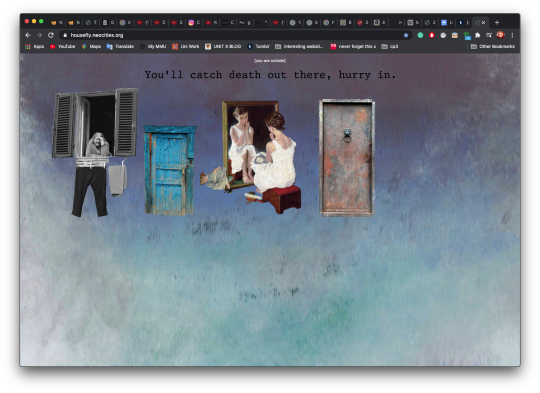



These are some of the websites I have found which were particularly interesting or inspiring to me. These websites are all examples of ways in which the medium of a website and the internet can be experimented with or used in ways that challenge the way we use the internet or the ways that websites should look or behave. Discovering these websites has been a way to expand my understanding of the internet and to explore beyond the usual top sites: Twitter, YouTube, Facebook, Amazon etc. But I also wanted to see the ways in which other artists and website creators utilise this medium and take the user through their site or offer a space that the user can explore.
In particular Erik Bernacci’s website takes the form of a computer desktop. In the bottom right corner there is a chat window where you can talk with ‘Erik’s Grumpy Cat’. By clicking on the different icons on the main page, the user can open different windows within the site. The ‘[email protected]’ icon allows the user to spray paint a 3d cast of the artists head virtually. Allowing the user to participate in the website and create new things with the artist’s creation. ‘W_R_U??.bin’ takes the form of a game, the user is asked questions or prompts and clicks on text answers or images to reply and play through the activity.
Who are you?/www.housefly.neocities.org encourages the user to explore. The user begins ‘outside’ and is faced with a home page that says ‘You’ll catch death out there, hurry in.’ and four images: a woman looking out of a window, two different doors and a girl sitting in front of a mirror. Clicking on one of these will allow the user to explore different pages of the site, some of which include poetry, GIFs and images, clicking on the illustrations or GIFs lead the user through the site with the option to ‘go back outside’ at the bottom of each page. This site is quite simple in execution: each page including a poem and/or one image and a different background for each page but this still creates an interesting space for the user to explore and it’s simplicity contrasts the bombardment of information that we often experience on social media or other spaces online. The experience, therefore, is quite relaxing and allows the user to be inquisitive. I also like the mystery of the site, there is no ‘about’ page to tell us why this website is here or what it’s for, it just exists and asks us to explore.
0 notes
Photo
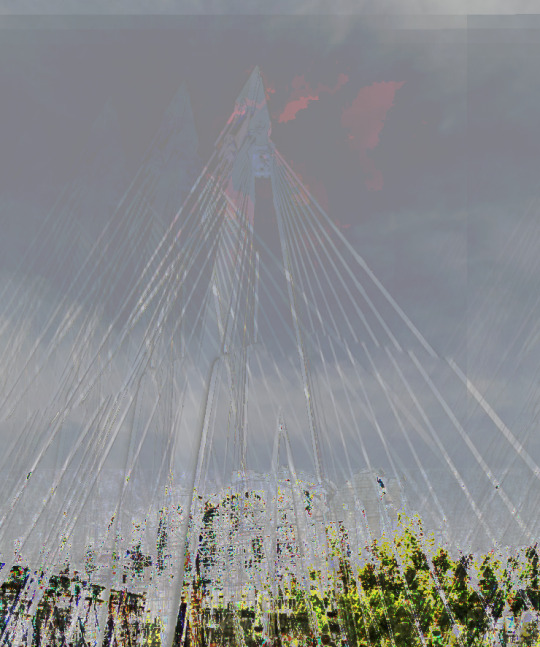


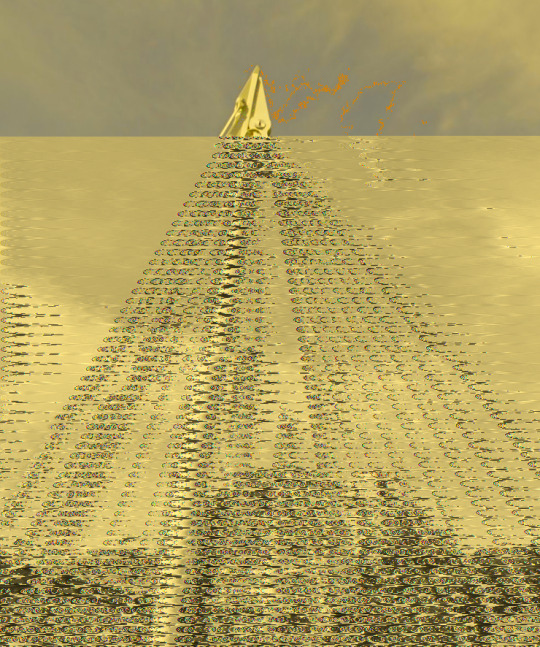
I took an image from my google maps dérive and decided to experiment with using the audio editing software, Audacity, as an image editing software. To do so you open the image in Audacity as a .tif file, it will show on the timeline as audio (which can be played but sounds like white noise and is extremely unpleasant), sound effects can then be applied to the data such as echo and reverb. The file can then be exported as raw data and copied into Photoshop to be changed into a .png or .jpg or to edit further. The images here have only be edited using Audacity. This was an interesting experiment, however, I can’t really see this having a place in my work right now. This might be something to return to or further explore in the future.
0 notes
Photo



notebook pages 6-1
I wrote the above notes on a blog post on Graphite Journal by Abby Castillo, ‘On The Psychogeographies Of Cities and The Internet’. Castillo draws comparison between the internet and the city as well as the way we travel through them and how Guy Debord’s ‘Theory of the Dérive’ can be applied to our web surfing in order to ‘delimit one’s life to an unchanging routine’ and explore the vast metropolis that is the internet.
Digital Dérive: I agree with Castillo’s point that we need a digital or internet dérive. It’s easy to forget the vast expanse of the internet when, on an average day, we limit ourselves to scrolling through the big four: youtube, facebook, amazon and twitter. It’s also easy to forget the level of customisation and expression that the web can offer when presented with cookie-cutter social media sights: [insert name here], [insert profile picture here].
Castillo suggests some ways to undertake a digital dérive, transgress the invisible control of algorithms and expand our psychogeography online (I have also added some of my own thoughts):
imagine the city as a large city or vast geographical space so that you can conceptualise your dérive
recognise your usual online routine, which sites do you frequent?
maybe actively avoid sites you usually frequent and ‘closed garden’ platforms
look for unusual routes and unexpected sights
try using the internet archive and the wayback machine to expand your potential terrain, this will allow you to explore across time as well as the digital
prioritise both the act and the concept of wandering, some websites and webpages are designed to be thoroughly explored whilst others are not so take the opportunity to dive into both
move towards the interesting, but also the significantly boring
perhaps deliberately turn off ad-blocking software (if installed) and click on ads that you would usually avoid
I now want to undertake a digital dérive using the bullet points above as my guide. I will record my dérive(s) through screen recordings and screen captures. I could also record them through other means such as: making a document or post of links to all the websites I visited, edited images of videos from things (images, videos, text, sounds, music etc.) I found on my dérive, or maybe I could make a fully ‘original’ piece of work based on/inspired by my dérive.
P.s. The article ‘On the Psychogeographies of Cities and the Internet’ was originally published under the name James Curry-Castillo however, the author now goes by Abby Castillo and will be referred to as such as per her request.
0 notes
Video
youtube
After reading about the dérive, and discussing the possibility of a ‘digital dérive’ in the Art and Internet reading group, I decided to carry out a dérive on google maps with my friend, Lauren. Using zoom to communication during our dérive, Lauren and I started at the same place and took a virtual walk through Manchester. Sadly, the audio of our dérive isn’t available however a screen recording can be viewed above. We wanted to start in the same place and see where we would both individually end up and how the format of Google Maps would sway where we went. As we went we both took screen captures of things that interested us, whether this be something within the city (within the images presented by Google Maps) or whether this be something to do with Google Maps itself.
0 notes
Text
‘Stop Googling. Let’s Talk.’, ‘The IRL Fetish.’ and ‘How I Grew Up On The Internet.’



I came across ‘Stop Googling. Let’s Talk’ and ‘The IRL Fetish’ when looking at the additional reading for the Art and the Internet reading group. Whilst I found ‘How I Grew Up On The Internet’ during my own research.
In Turkle’s ‘Stop Googling. Let’s Talk’, she argues that nowadays we are shamelessly dividing our attention between ‘the real world’ and our phones causing conversation to become less ‘open-ended and spontaneous’ and less meaningful. She calls for a reclaim of conversation as ‘conversation is the most human and humanising thing that we do’, and a reclaim of solitude and the ability to be by ourselves. The article reads like a call to arms and I was ready to fight off the phones and revive the conversation. But after about a week I started to rethink Turkle’s argument in terms of my own life, conversation, friendships and smartphone. Whilst she does include some interesting research she definitely has a biased approach. In the last week or so, I have been to quite a few social gatherings and I can’t think of one where the conversation, atmosphere or the evening as a whole was greatly affected by our smartphones. At the bar some of us kept our phones in our bags or pocket, whilst others left them face up on the table next to their drinks, baccy and keys. Any use of a phone was preceded by an excuses, ‘do you mind if I text _____? need to ask if she’s on her way’ and it always felt as if the conversation/’the real world’ was a priority over the world of our phones. Our conversation went from small talk, ‘how have you been? how’s uni?’, to jokes and banter, to deeper, more serious topics, to anecdotes and so on. Not once did I feel like the conversation significantly suffered due to the invention of the smartphone, or the fact that our smartphones were there with us. Steve Jobs first revealed the iPhone in 2007, 13 years ago, but the capabilities of smartphones now far surpasses what we could have imagined a phone could do back then. And it still seems slightly crazy that we all have portable computers in our back pockets, connecting us to each other in one large network. But its easy to forget that before smart-phones were the big bad, video-games were going to turn children violent: they were the scapegoat for school shootings and they were going to create a generation of aggressive teens moving into adulthood; but before video-games films and television were going to make us all couch potatoes who were defenceless to the power of advertising and would be easily influenced the fiction we saw acted out on screen; the invent of written communication was feared by Socrates who thought it would lead us to become forgetful and that the written word was less human than the spoken. When we place Turkle’s argument into this context we see a very clear trend; as a species we fear ‘the new’, in fact we fear it will make us less human. But what can be more human than expressing ourselves through the written word, or empathising with a fictional character on television, or wanting to experience and explore new worlds through a video-game, or wanting to communicate and share experiences with others?
0 notes
Photo


These pieces above are a result of my experimentation with found images on the web and image manipulation using Adobe Photoshop. I used online advertisements as well as an image of Lisa Simpson using the computer (from the popular television series, The Simpsons). I wanted to take images from the internet that are recognisable to the average user (such as 'one weird trick’ ads which promise drastic weight loss under the headline or slogan of ‘cut down 3 lbs of your belly every week by following this one weird old tip’, or ads that offer dubious looking coupon codes on the latest laptops or gaming consoles and so on) and manipulate them to the point where they are almost unrecognisable. The point of these ads is to capture the attention of the user (particularly targeting more naive users, possible older people who are less educated on the internet scams) and can be spotted through their poor use of design and use of the same images or illustrations. I edited, collaged and altered my screenshots of these ads to the point where they were largely unrecognisable, some of them now look pixelated - just large squares as part of the composition. Whilst creating these two pieces, I was considering our relationship to online advertising (mainly for illegitimate services). Is online advertising the backdrop to our online experience? Or is it a kind of online currency (?) - in order to view this content you must consume these weird, dubious advertisements. I felt like the first image was missing something, hence my inclusion of Lisa Simpson in the second and my further manipulation of the colours in the images. In the Simpson image, Lisa is using an older computer at a time before online advertising became significant and when the internet was still in its infancy. I am too young to remember the computers/internet shown in this cartoon image of Lisa but I think for a lot of people there is a nostalgia surrounding the ‘old’ internet, but I wonder was it actually better? In terms of technological advances, the answer is no. But what about in terms of user experience, freedom and expression?
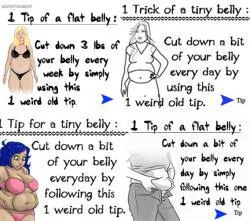
0 notes
Text
Reflecting on feedback for Studio Practice 3B
Overall I achieved 68% on this unit, painfully close to a first but not quite there. I am happy with the grade I got, however, I feel that what I learned about my ways of working and my practice were far more valuable. I learnt that I am the type of person who cannot work to a strict regime or schedule, instead I work better with lists that identify the minimum I need to get done with additional tasks to do when I am feeling motivated. This is because one of my bad habits first thinking about what I need to get done and then thinking ‘that won’t take long’ or ‘that’s not much work’ when really I have a shit tonne to do. One of the things I find the hardest about getting stuff done is, in fact, the simplest: sitting down at my desk and starting something. In the past this has led me to believe that I’m lazy, have a poor work ethic and that I can’t motivate myself to work when there’s no one around to dish out consequences. These thoughts are actually not true and quite unhealthy to think about yourself. There are a couple of things I have been doing to motivate me to sit down at my workspace and get at least an hour of work done per day (except for the maximum of 2 days off per week): (1) I have a piece of gridded paper at my workspace, and for every day I sit down and work I can draw a little cross in one of the boxes, the idea being that this creates a chain and if I don’t work there’s a break in the chain, (2) I have a to do list with daily tasks, but also tasks for the future and tasks with due dates on, this allows me to think about the timeframe I am working with and about the bigger picture, (3) at the end of the day I will add tasks to my list for the next day or will leave something for myself to do tomorrow (e.g. I’ll leave a Photoshop document open so that when I look at my computer I’ll have to think about what I’ve been working on). These sounds stupidly simple but I’m scared that if I don’t write them down I will forget these little habits that seem to make me a more productive person: I’ve gone from working super sporadically to being able to work for at least 2 hours a day, sometimes 8 hours. The ‘trick’ I use to get myself to work is by following my list, and my chain of xs but also starting with written work or reading (which I find easier) and, if I’m really not in the mood, I tell myself that if I’m still hating it or bored or whatever after 2 hours I can stop. This sounds like a scenario where I’m allowing myself to only work 2 hours a day, but in actual fact I usually end up getting absorbed in my work to the point where it’s dark out, tea’s ready and I’m still trying to edit a gif or write up my thoughts on an artist.
Feedback
Firstly, my tutor says he likes my gifs of scrolling through instagram but that the smoothly hypnotic experience of scrolling is lost in the way the gif doesn’t properly loop, causing a jagged effect, and that my Simpson’s gif almost works better because it has this continuous loop to it. I definitely agree with this feedback, i think that my gifs are way more successful when there is a constant loop rather than a beginning and end. This is something I getting better at doing through experimentation with creating gifs and through getting better at using Photoshop and all its features. Also without a clear beginning and end, I think gifs can be more interesting because they have that hypnotic feel and it’s up to the user to decide on where they think the ‘beginning’ or ‘end’ are supposed to be and if the gif has one at all.
Secondly, my tutor asks me to identify which aspects of this topic interest me more and suggests that this could help me focus as I move into my third year. Again I completely agree with this feedback, I have already started to research the specific aspects of the subject matter that interest me most in the hopes that I’ll be able to focus my work more. The specific areas I am most interested in are: (1) is the internet controlled or free?, (2) the information economy: how we, as users, give over our personal information and in return we are allowed to use services on the internet (mainly social media), (3) the overwhelming amount of information presented to us on a daily basis due to the internet and our ability to deal with the never-ending pool of information. I am currently working my way through a large pile of books and Jstor articles. :)
Finally, he also suggested some artists/groups/projects to research such as jodi.org, Zach Blas and Lauren McCarthy.
0 notes


